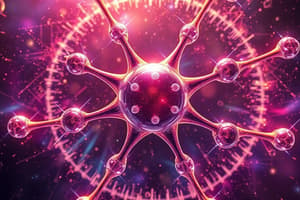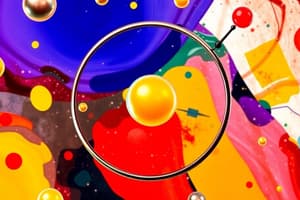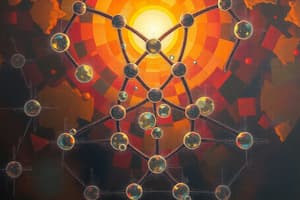Podcast
Questions and Answers
Which of the following compounds is a strong base?
Which of the following compounds is a strong base?
- NaCl
- Ca3(PO4)2 (correct)
- NH4I
- Zn(NO3)2
Which of the following is NOT a reason why cells divide?
Which of the following is NOT a reason why cells divide?
- Growth
- Reproduction
- Nutrient Transport (correct)
- Repair
During which phase of the cell cycle does the cell spend most of its time?
During which phase of the cell cycle does the cell spend most of its time?
- Interphase (correct)
- Metaphase
- Prophase
- Anaphase
What is a common characteristic of cancer cells?
What is a common characteristic of cancer cells?
Which of the following biological processes can be disrupted by a failure of checkpoints during the cell cycle?
Which of the following biological processes can be disrupted by a failure of checkpoints during the cell cycle?
What is the primary purpose of the provided list of topics?
What is the primary purpose of the provided list of topics?
What is the implication of the statement 'If the sample questions are insufficient... '?
What is the implication of the statement 'If the sample questions are insufficient... '?
Which of the following best describes the type of content provided in the list of topics?
Which of the following best describes the type of content provided in the list of topics?
What is the suggested approach for students who find the provided sample questions inadequate?
What is the suggested approach for students who find the provided sample questions inadequate?
What is the intended audience for the provided list of topics?
What is the intended audience for the provided list of topics?
Which of the following is NOT a common cause of cancer?
Which of the following is NOT a common cause of cancer?
What is the purpose of a mammogram?
What is the purpose of a mammogram?
Which of the following is an example of a specialized cell found in plants?
Which of the following is an example of a specialized cell found in plants?
What is the function of the circulatory system?
What is the function of the circulatory system?
How does the respiratory system work together with the circulatory system?
How does the respiratory system work together with the circulatory system?
What is the main function of the musculoskeletal system?
What is the main function of the musculoskeletal system?
Which of the following is NOT a component of the digestive system?
Which of the following is NOT a component of the digestive system?
What is the main function of the nervous system?
What is the main function of the nervous system?
What is the coefficient needed for oxygen in the following chemical equation?
$4Fe + □ O_2 ⟶ 2Fe_2O_3$
What is the coefficient needed for oxygen in the following chemical equation?
$4Fe + □ O_2 ⟶ 2Fe_2O_3$
What is NOT a property of acids?
What is NOT a property of acids?
Which of the following is a combustion reaction?
Which of the following is a combustion reaction?
What are the coefficients needed to balance the following chemical equation?
$N_2 + H_2 ⟶ NH_3$
What are the coefficients needed to balance the following chemical equation?
$N_2 + H_2 ⟶ NH_3$
When a chemical reaction follows the law of conservation of mass, what does it mean?
When a chemical reaction follows the law of conservation of mass, what does it mean?
Identify the correct balanced chemical equation for the following chemical reaction:
barium chloride + magnesium sulfate ⟶ barium sulfate + magnesium chloride
Identify the correct balanced chemical equation for the following chemical reaction:
barium chloride + magnesium sulfate ⟶ barium sulfate + magnesium chloride
What is the acidic reactant that reacted with the hydroxide base to produce sodium chloride?
What is the acidic reactant that reacted with the hydroxide base to produce sodium chloride?
What is the type of chemical reaction that occurs when calcium carbonate ($CaCO_3$) decomposes into calcium oxide ($CaO$) and carbon dioxide ($CO_2$)?
What is the type of chemical reaction that occurs when calcium carbonate ($CaCO_3$) decomposes into calcium oxide ($CaO$) and carbon dioxide ($CO_2$)?
What is the main distinction between a positive and a negative feedback loop in relation to climate change?
What is the main distinction between a positive and a negative feedback loop in relation to climate change?
What types of evidence can be used to reconstruct the Earth's past climate?
What types of evidence can be used to reconstruct the Earth's past climate?
Which of the following is NOT a direct consequence of rising global temperatures?
Which of the following is NOT a direct consequence of rising global temperatures?
What is the primary mechanism by which greenhouse gases cause the Earth to warm up?
What is the primary mechanism by which greenhouse gases cause the Earth to warm up?
Which of the following careers is directly related to the study and understanding of climate change?
Which of the following careers is directly related to the study and understanding of climate change?
When light travels from air to water, what happens to the speed of light?
When light travels from air to water, what happens to the speed of light?
What type of mirror is used in a car's rearview mirror?
What type of mirror is used in a car's rearview mirror?
What happens to the image when an object is placed at the focal point of a converging lens?
What happens to the image when an object is placed at the focal point of a converging lens?
What is the primary function of the cornea in the human eye?
What is the primary function of the cornea in the human eye?
What type of lens is used to correct myopia (nearsightedness)?
What type of lens is used to correct myopia (nearsightedness)?
What is the primary cause of the greenhouse effect?
What is the primary cause of the greenhouse effect?
Which of the following is NOT a greenhouse gas?
Which of the following is NOT a greenhouse gas?
What is the difference between weather and climate?
What is the difference between weather and climate?
Which of the following is a short-term variation in climate?
Which of the following is a short-term variation in climate?
Which of the following is NOT a factor that influences the absorption of heat by different regions of the Earth?
Which of the following is NOT a factor that influences the absorption of heat by different regions of the Earth?
Flashcards
Self-Directed Studies
Self-Directed Studies
Independent learning where students seek out resources and practice.
Practice Questions
Practice Questions
Questions used to help students prepare for an exam.
Insufficient Sample Questions
Insufficient Sample Questions
When provided questions are not enough for adequate preparation.
Exam Review
Exam Review
Signup and view all the flashcards
Finding More Resources
Finding More Resources
Signup and view all the flashcards
Acids and Bases
Acids and Bases
Signup and view all the flashcards
Neutralization Reaction
Neutralization Reaction
Signup and view all the flashcards
Cell Cycle
Cell Cycle
Signup and view all the flashcards
Mitosis
Mitosis
Signup and view all the flashcards
Cancer Checkpoints
Cancer Checkpoints
Signup and view all the flashcards
Common Causes of Cancer
Common Causes of Cancer
Signup and view all the flashcards
Types of Cancer
Types of Cancer
Signup and view all the flashcards
Cancer Screening Methods
Cancer Screening Methods
Signup and view all the flashcards
Specialized Cells
Specialized Cells
Signup and view all the flashcards
Cell Structure and Function
Cell Structure and Function
Signup and view all the flashcards
Human Organ System
Human Organ System
Signup and view all the flashcards
Organ Similarities (Human vs Frog)
Organ Similarities (Human vs Frog)
Signup and view all the flashcards
Interconnected Organ Systems
Interconnected Organ Systems
Signup and view all the flashcards
Positive Feedback Loop
Positive Feedback Loop
Signup and view all the flashcards
Negative Feedback Loop
Negative Feedback Loop
Signup and view all the flashcards
Anthropogenic Greenhouse Gases
Anthropogenic Greenhouse Gases
Signup and view all the flashcards
Climate History Clues
Climate History Clues
Signup and view all the flashcards
Rising Temperatures Effects
Rising Temperatures Effects
Signup and view all the flashcards
Virtual Image
Virtual Image
Signup and view all the flashcards
Concave Mirror
Concave Mirror
Signup and view all the flashcards
Convex Mirror
Convex Mirror
Signup and view all the flashcards
Refraction
Refraction
Signup and view all the flashcards
Index of Refraction
Index of Refraction
Signup and view all the flashcards
Total Internal Reflection
Total Internal Reflection
Signup and view all the flashcards
Converging Lens
Converging Lens
Signup and view all the flashcards
Diverging Lens
Diverging Lens
Signup and view all the flashcards
Myopia
Myopia
Signup and view all the flashcards
Greenhouse Effect
Greenhouse Effect
Signup and view all the flashcards
Conservation of Mass
Conservation of Mass
Signup and view all the flashcards
Balancing Equations
Balancing Equations
Signup and view all the flashcards
Chemical Reaction Types
Chemical Reaction Types
Signup and view all the flashcards
Combustion Reaction
Combustion Reaction
Signup and view all the flashcards
Acid-Base Reactions
Acid-Base Reactions
Signup and view all the flashcards
Identifying Reactions
Identifying Reactions
Signup and view all the flashcards
Coefficients in Equations
Coefficients in Equations
Signup and view all the flashcards
Properties of Acids and Bases
Properties of Acids and Bases
Signup and view all the flashcards
Study Notes
Atomic Structure and Diagrams
- Atoms and ions are differentiated
- Bohr-Rutherford and Lewis dot diagrams can be drawn for the first 20 elements on the periodic table
Types of Compounds (Ionic, Molecular, Polyatomic)
- Compounds are made of two or more atoms
- Ionic and molecular compounds have different bonding characteristics
- Variations in element types lead to changes in compound properties
- Chemical formulas can be determined from compound names
- Chemical names can be determined from chemical formulas
- Multivalent ionic compounds are named and written correctly
- Molecular compounds use prefixes, specifically in binary compounds
- Chemical formulas are identified when chemical names are known
Chemical Equations
- Polyatomic ions are treated as a whole unit
- Word equations and chemical equations use knowledge of chemical compound naming
- Conservation of mass principle applies to chemical equations
- Reactants are balanced with products
- Correct coefficients should be used in front of molecules
- The number of atoms of each element must be equal
Balancing Equations (Conservation of Mass)
- Mass of reactants equals mass of products
- Use correctly to follow the conservation of mass law
- Equations are balanced by adding coefficients in front of molecules
Types of Chemical Reactions
- Acids and bases are compared regarding similarities and differences
- Acids and bases, including strong and weak ones, are identified
- The products of neutralization reactions are water and a salt (ionic compound)
- Neutralization brings pH level close to 7
Cell Cycle and Cell Division
- 3 reason why cell division occurs (growth, repair, and reproduction)
- Cells spend most of their time in the growth phase; a smaller portion is in the division phase
- The various stages of mitosis are to be explained
Cancer and Treatment
- Cancer cell characteristics are described and cancer cell growth and division are explained
- Factors contributing to cancer formation are determined
- Cancer screening, diagnosis, and treatment are explained
Evidence of Climate Change
- Clues from the past are used to determine the climatic history of the planet
- The cause and effects of increased temperatures are explained
- Human effects on carbon, methane, and nitrous oxide cycling are discussed
- Sources of anthropogenic greenhouse gases and their effects are outlined
Earth Science - Climate Change
- Differentiate between weather and climate and periods
- The relationship between the sun's radiation, infrared radiation, and global temperature is understood
- Climate zones and their effects on heat absorption are explained
- Greenhouse effect and its mechanisms are explained
- Understanding different greenhouse gases and blocking thermal energy
- Short-term climate variations are explained, from volcanic activity to ocean currents
- Positive and negative feedback loops affecting climate are identified
Specialized Cells
- Specialized cell locations, structures, and functions are identified and explained
- Changes in structure and cell function can be explained
Organ Systems
- Organ systems' purpose, inputs, outputs, components, and processes are explained
- Organ systems (respiratory, cardiovascular, musculoskeletal, reproductive, nervous, digestive) are identifiable
- How organ systems work together is described
Images in Plane and Curved Mirrors
- Real and virtual images, and their characteristics, are distinguished
- Concave and convex mirrors are explained
- Image location and characteristics are determined using incidence and reflected rays
- The SALT acronym is used for image characteristics, that refer to the Size, Attitude, Location, and Type
Refraction, Index of Refraction, Total Internal Reflection
- Refraction is explained and how it impacts light
- The index of refraction and calculating light speed in different mediums are illustrated
- Conditions for total internal reflection are explained
Lenses
- Converging and diverging lenses are identified and their shapes are described
- Ray diagrams are created to describe imaging using lenses
- Eye conditions (hyperopia, presbyopia, myopia) and correction are explained
The Human Eye
- Identifying the various parts of the eye and their function
Studying That Suits You
Use AI to generate personalized quizzes and flashcards to suit your learning preferences.



